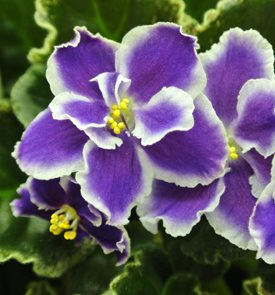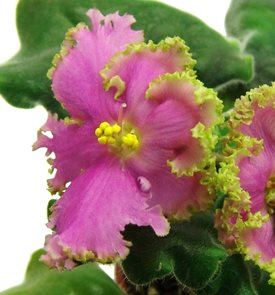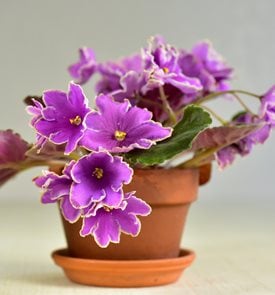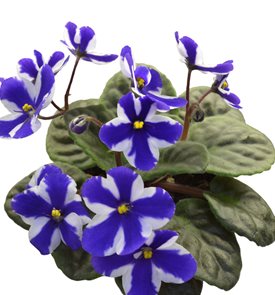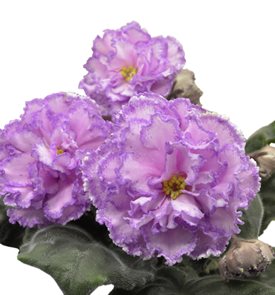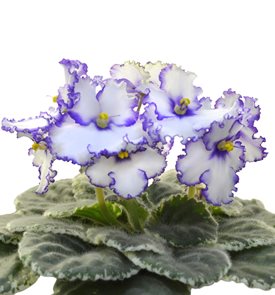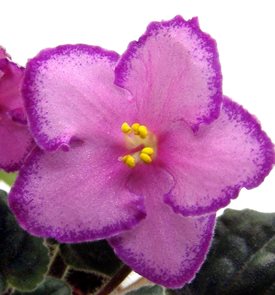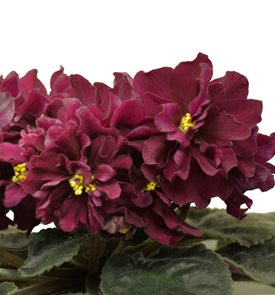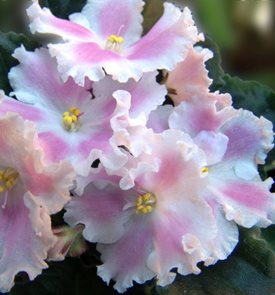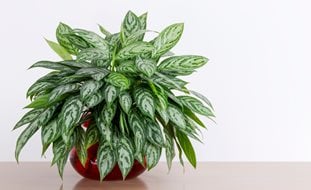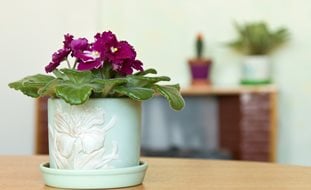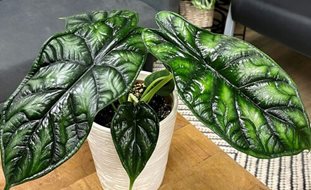A Guide to Growing & Caring for African Violets
Get growing and care tips along with tried-and-true strategies for keeping your plants in bloom.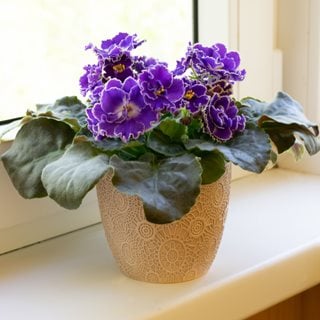
Photo by: Sunny_Smile / Shutterstock
Since they were first discovered in East Africa in the 1890s, African violets have become one of the most widely grown houseplants in the world and remain on the top of any list of favorite flowering plants.
The fact that African violets continue to have such a passionate following attests to their unrivaled beauty and ease of care. Few other houseplants can match their ability to thrive and bloom indoors for months on end. Plus, their compact size makes them perfect for adorning windowsills, desktops, and tables. And despite their reputation for being temperamental, these tropical natives are really not that difficult to grow if you follow a few important rules.
On this page: Basics | Growing | Care | Varieties | Tips to Keep Blooming
On this page:
- AFRICAN VIOLET BASICS
- GROWING AFRICAN VIOLETS
- AFRICAN VIOLET CARE
- AFRICAN VIOLET VARIETIES
- TIPS TO KEEP AFRICAN VIOLETS BLOOMING
BASICS
Botanical name:
Saintpaulia ionantha
Common name:
African violet
Origin:
Tropical rainforest regions of eastern Africa, near the border of Tanzania and Kenya
Habit/size:
Most plants form rosettes ranging in height from 4 to 6 inches and in diameter from less than 3 inches (for miniature varieties) to over 16 inches. Although less common, you can also find trailing African violets that have a cascading habit, with multiple crowns growing from the same root system.
Foliage:
The thick, fuzzy leaves of African violets are almost as varied as the flowers. Some are long and narrow, others are almost round, and the margins may be smooth, serrated, fringed, or wavy. The color may be pale green, dark green or bronze, with contrasting silvery white, rose or deep purple undersides. Some cultivars have variegated foliage accented by cream, pink, or white.
Flowers:
Five-petaled, violet-like flowers come in a palette of colors including white, pink, red, violet-blue, deep purple, cream, bicolored, and picotee. The blooms range in size from 1 to 2-1/2 inches across and may be single, semi-double or double, with frilled or ruffled edges.
Bloom time:
Will repeat bloom throughout the year under ideal conditions, with the bloom period lasting about a month before plants take a short rest as they prepare to form new flowers.
Are African violets poisonous?
No, they are nontoxic and pet friendly, according to the ASPCA. See more common plants safe for cats and dogs.
How long do African violets live?
With the proper care, they have a lifespan as long as 50 years.
Are African violets true violets?
African violets aren’t really violets at all but instead are members of the Gesneriad family, which includes gloxinias (Sinningia speciosa) and lipstick plants (Aeschyanthus spp.).
GROWING AFRICAN VIOLET PLANTS
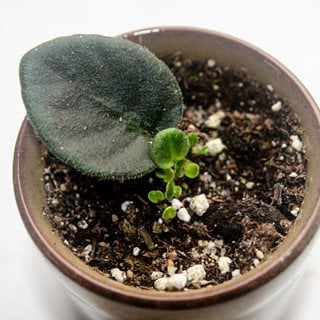
Photo by: Pegasene / Shutterstock
Light:
Place plants in a spot that receives plenty of bright indirect light, such as close to an east- or north-facing window or set back from a south- or west-facing window. Avoid exposing to direct afternoon sun in the summer, which can burn the sensitive foliage. (See below for more about lighting under Tips for Keeping African Violets in Bloom.)
Temperature:
These flowering tropicals prefer a warm, humid environment that simulates their native jungle habitat. Ideal room temperatures range between 60 to 65 F degrees at night and 70 to 80 degrees F during the day.
Humidity:
If your home is dry, provide supplemental humidity, especially during the winter months, by placing plant pots on a shallow dish or tray filled with pebbles and water.
Soil type:
Use a commercial, soilless mix formulated specifically for African violets. Typically, a blend of sphagnum peat moss, vermiculite and perlite, these mixes are designed to retain moisture while allowing for good drainage and air flow. Saintpaulia have fine root systems and are prone to root and crown rot if the mix is not porous and well-aerated.
Pot requirements:
African violets will grow well in both porous and non-porous containers. Porous containers, such as unglazed terracotta pots, are the best choice if you are bottom watering or using a wick system because they will absorb moisture while allowing the roots to breathe. You can also find small ceramic or plastic self-watering containers for African violets that will deliver the proper amount of water to keep the potting mix evenly moist.
When it comes to container size, African violets like to live in tight quarters and prefer pots that are slightly too small. Most bloom best in a container that is about a third the diameter of the plant’s leaf spread.
Propagation:
From leaf cuttings or division. If your African violet plant has developed multiple crowns, you can gently separate them to grow new plants.
AFRICAN VIOLET CARE
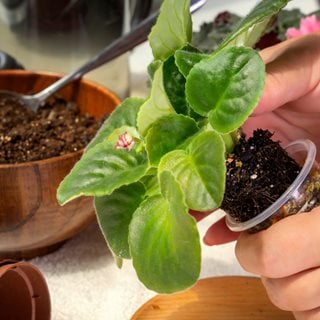
Photo by: Alexey_Arz / Shutterstock
Watering:
Keep the potting mix evenly moist but not soggy, using only room-temperature water. African violet leaves are very sensitive to cold water and can develop permanent spots where the water contacts the foliage. If watering from above, use a can with a long, slender spout that can be placed near the base of the plant to avoid getting water droplets on the leaves.
An alternative is to use a self-watering container or to water from below by placing the pot in a dish or saucer filled with about an inch of lukewarm water, pouring off any excess water not soaked up by the plant after an hour has passed.
Even if you prefer to water from below, you should give your plants a heavy watering from above every few months to flush out mineral salts that have accumulated in the soil from previous waterings or fertilizer applications.
Fertilizing:
Apply a fertilizer specifically formulated for African violets, following the dosage recommendations on the label. Reduce fertilizing during the winter months, when plants are at rest.
Pruning:
Pinch off spent flowers and dying stems as you notice them to encourage the development of new blooms. Also remove the lower, older leaves when they begin to fade. It’s natural for these bottom leaves to die off as they age.
Leaf care:
The soft, downy leaves of African violets have a tendency to collect dust and dirt. To clean them, brush off the dirt gently with a small soft-bristled paintbrush, but avoid touching the foliage directly with your hands.
Researchers from the Department of Horticulture and Landscape Architecture at Oklahoma State University have discovered that if you touch the leaves of African violets repeatedly, particularly with bare hands to which lotion has been applied, it can actually stunt their growth. However, infrequent touching for pruning and upkeep will do little harm.
Repotting:
Signs that it’s time to repot an African violet include the development of an extended crown and roots poking through the pot’s drainage holes or peeking above the soil surface. Repotting is also a good opportunity to divide plants that have developed multiple crowns and to refresh the potting mix to replenish depleted nutrients.
Because Saintpaulia flower best when snug in their pots, choose a new container that’s only slightly larger than the existing one (or use the same container in the case of mature plants). As you shift your plant into its new pot, be careful not to bury the crown. It should be set just above the surface of the fresh potting mix.
Pests and diseases:
Root and crown rot due to excessive watering or poor drainage are the most common problems. Also be on the lookout for powdery mildew, cyclamen mites, mealybugs, and aphids.
AFRICAN VIOLET VARIETIES
There are thousands of African violet cultivars to choose from, representing an astounding array of flower colors, forms, and sizes. To see the full breadth of options, visit the photo gallery of the African Violet Society of America, a collection of over 3,000 African violet photos submitted by members.
TIPS TO KEEP YOUR AFRICAN VIOLETS BLOOMING
African violets will bloom almost continuously throughout the year if you satisfy their basic needs. Here’s what it takes to keep them in flower and looking fresh:
- Get the right amount of light. Although African violets flower in significantly less light than most other flowering houseplants, they must receive 10 to 14 hours of bright indirect light daily for optimal blooming. “Although an east window is believed to provide the most desirable aspect for them, it is the amount of light they receive rather than their orientation that is the determining factor,” says Montague Free, author of All About African Violets: The Complete Guide to Success With Saintpaulias. Another tip: Rotate your plants a quarter-turn every week to maintain their nice, symmetrical form.
- Change the location of your African violets depending on the season. Move them to a sunnier south- or west-facing window during the winter and a north- or east-facing window during the summer to avoid direct exposure to midday sun. The use of grow lights is another way to coax more blooms from your plants during the winter months.
- Fertilize correctly. Although you need to feed African violets regularly to encourage them to bloom, too much fertilizer can result in poor flowering and the accumulation of salts in the soil, which can be harmful to plant health. Use an African violet food to ensure the right proportions of nutrients, and flush the soil occasionally with clear water to eliminate salt buildup. For the best results, use a liquid fertilizer that you can dilute as needed.
- Prune the outside leaves. Another technique to stimulate blooming is to prune the outside leaves of your plants to give the inside rows a chance to produce flowers, recommends the Missouri Botanical Garden. Each row of African violet leaves will produce flowers only once. When the plant has more than five rows of leaves, the number and size of blossoms will begin to decline.
- Monitor the temperature of your home. The growth and flowering of African violets will slow considerably if room temperatures fall below 60 degrees F, and plants can sustain permanent damage at temperatures below 50 degrees F. If you live in a cold climate, avoid exposing them to sudden temperature changes by keeping them away from cold windows and drafts. As a general rule of thumb, room temperatures that feel comfortable to you are also ideal for your African violets.
